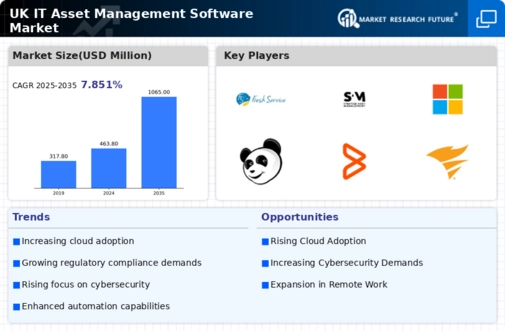Increased Regulatory Requirements
the IT Asset Management Software Market is significantly influenced by the increasing regulatory requirements imposed on organizations in the UK. Compliance with data protection regulations, such as the General Data Protection Regulation (GDPR), necessitates the implementation of effective asset management solutions. Companies are compelled to ensure that their IT assets are managed in a manner that adheres to these regulations, thereby mitigating risks associated with data breaches and non-compliance penalties. The financial implications of non-compliance can be severe, with fines reaching up to €20 million or 4% of annual global turnover, whichever is higher. As a result, organizations are investing in it asset-management-software to enhance their compliance posture, which is likely to drive market growth in this sector.
Shift Towards Remote Work Solutions
the IT Asset Management Software Market is witnessing a shift towards solutions that support remote work environments. As more organizations in the UK adopt flexible working arrangements, the need for effective management of IT assets across distributed locations becomes increasingly critical. This shift is prompting companies to invest in software that enables remote monitoring, management, and support of IT assets. The market is projected to grow by approximately 15% annually as businesses seek to ensure that their remote workforce has access to the necessary tools and resources. This trend highlights the importance of adaptability in asset management practices, which is essential for maintaining productivity and operational efficiency in a remote work setting.
Growing Importance of Data Analytics
the IT Asset Management Software Market is being propelled by the growing importance of data analytics in asset management practices. Organizations in the UK are increasingly recognizing the value of data-driven decision-making, which necessitates the integration of advanced analytics capabilities into asset management software. By leveraging data analytics, companies can gain insights into asset performance, utilization trends, and potential areas for optimization. This analytical approach can lead to improved asset lifecycle management and reduced costs. It is estimated that organizations utilizing data analytics in their asset management processes can achieve efficiency improvements of up to 25%. Consequently, the demand for it asset-management-software that incorporates robust analytics features is likely to rise.
Rising Demand for IT Asset Visibility
the IT Asset Management Software Market is experiencing a notable increase in demand for enhanced visibility of IT assets. As organizations in the UK strive to optimize their IT infrastructure, the need for comprehensive tracking and management of assets becomes paramount. This demand is driven by the necessity to reduce operational costs and improve efficiency. According to recent data, companies that implement effective asset management solutions can achieve cost savings of up to 30%. Furthermore, the growing complexity of IT environments necessitates robust software solutions that provide real-time insights into asset utilization and lifecycle management. This trend indicates a shift towards more sophisticated asset management practices, which is likely to propel the growth of the IT Asset Management Software Market in the coming years.
Emergence of Subscription-Based Models
the IT Asset Management Software Market is experiencing a shift towards subscription-based models, which are becoming increasingly popular among organizations in the UK. This trend is driven by the desire for cost-effective solutions that offer flexibility and scalability. Subscription models allow businesses to access the latest software updates and features without the burden of large upfront costs. This approach is particularly appealing to small and medium-sized enterprises (SMEs) that may have limited budgets for IT investments. The subscription-based model is projected to account for over 40% of the market share by 2026, indicating a significant transformation in how organizations procure and utilize asset management software. This shift is likely to enhance accessibility and drive further adoption of it asset-management-software.






















Leave a Comment